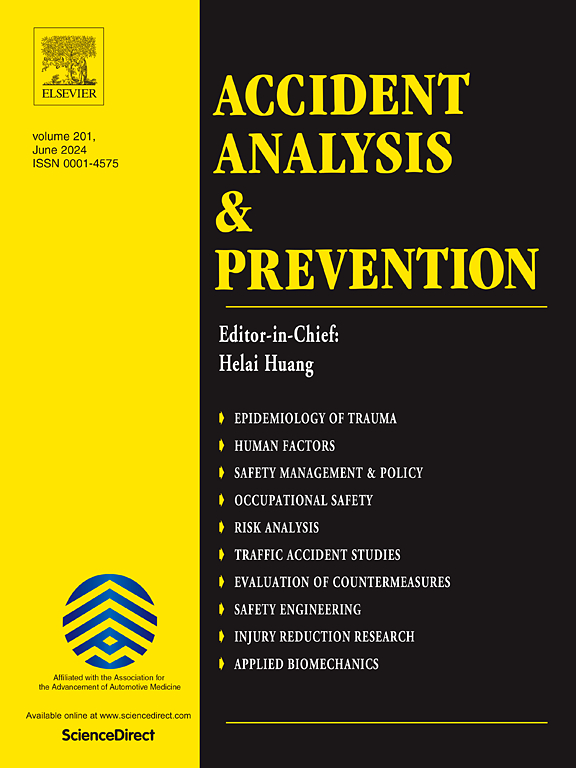考虑车道宽度和密封肩宽同时变化的宽中心线处理前后安全性评价
IF 6.2
1区 工程技术
Q1 ERGONOMICS
引用次数: 0
摘要
宽中心线处理(WCLT)通常通过同时调整车道宽度和密封肩宽来实现,以最大限度地减少对道路拓宽的需求。然而,迄今为止的研究在评估WCLT的安全性有效性时忽略了这些并发变化,可能导致不可靠的结论。因此,本文旨在评估WCLT的安全有效性,同时考虑车道宽度和密封肩宽的同时变化,以提供更可靠和全面的评价。采用基于前后模拟的经验贝叶斯方法,采用参数化过分散的面板随机参数负二项模型。具体而言,本研究评估了在车道宽度和密封肩宽变化(增加、减少和恒定)组合的九种处理条件下WCLT的碰撞修正因子。结果表明,增加车道宽度和封闭肩宽的WCLT可使总伤害事故减少74.33%,致命和严重伤害事故减少73.40%,正面事故减少41.16%,越野车事故减少72.54%。另一方面,减小车道宽度和封闭肩宽的WCLT效果较差,总伤害事故减少43.79%,致命和严重伤害事故减少42.54%,正面事故减少60.66%,越野车事故减少0.76%。这项研究将有助于道路设计者在实施WCLT时做出明智的决定。本文章由计算机程序翻译,如有差异,请以英文原文为准。
A before-after safety evaluation of wide centerline treatment considering the simultaneous changes in lane width and sealed shoulder width
Wide Centerline Treatment (WCLT) is typically implemented by simultaneous adjustments to lane widths and sealed shoulder widths to minimize the need for road widening. Studies to date, however, have overlooked these concurrent changes when assessing the safety effectiveness of WCLT, potentially leading to unreliable conclusions. Therefore, this paper aims to assess the safety effectiveness of WCLT while accounting for simultaneous changes in the lane width and sealed shoulder width to provide a more reliable and comprehensive evaluation. A before-after simulation-based Empirical Bayes approach is adopted by using a Panel Random Parameters Negative Binomial model with parameterized overdispersion. Specifically, the study evaluates crash modification factors of WCLT for nine treatment conditions in combinations of lane width and sealed shoulder width changes (increase, decrease, and constant). The results suggest that WCLT with both increased lane width and sealed shoulder width reduces total injury crashes by 74.33%, fatal and serious injury crashes by 73.40%, head-on crashes by 41.16%, and run-off-road crashes by 72.54%. On the other hand, WCLT with both decreased lane width and sealed shoulder width is found to be less effective, with a reduction in total injury crashes by 43.79%, fatal and serious injury crashes by 42.54%, head-on crashes by 60.66% and run-off-road crashes by 0.76%. This study will assist roadway designers in making informed decisions for implementing WCLT.
求助全文
通过发布文献求助,成功后即可免费获取论文全文。
去求助
来源期刊

Accident; analysis and prevention
Multiple-
CiteScore
11.90
自引率
16.90%
发文量
264
审稿时长
48 days
期刊介绍:
Accident Analysis & Prevention provides wide coverage of the general areas relating to accidental injury and damage, including the pre-injury and immediate post-injury phases. Published papers deal with medical, legal, economic, educational, behavioral, theoretical or empirical aspects of transportation accidents, as well as with accidents at other sites. Selected topics within the scope of the Journal may include: studies of human, environmental and vehicular factors influencing the occurrence, type and severity of accidents and injury; the design, implementation and evaluation of countermeasures; biomechanics of impact and human tolerance limits to injury; modelling and statistical analysis of accident data; policy, planning and decision-making in safety.
 求助内容:
求助内容: 应助结果提醒方式:
应助结果提醒方式:


